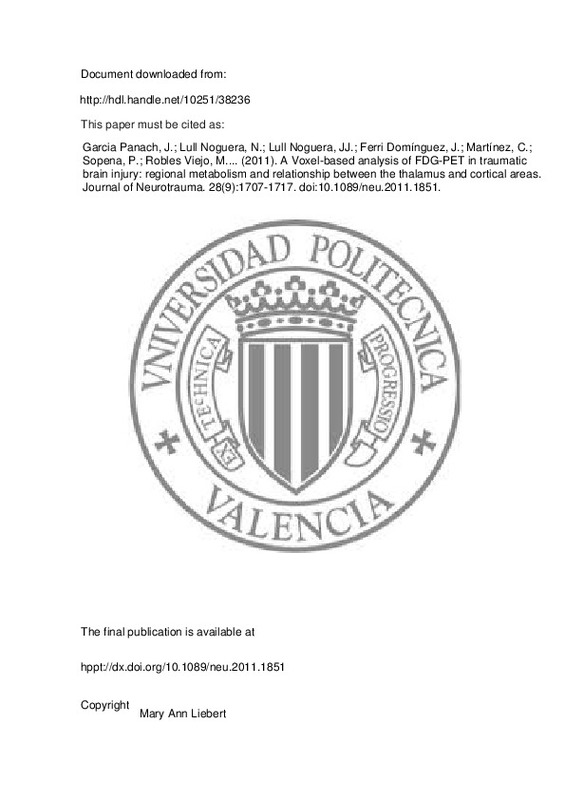JavaScript is disabled for your browser. Some features of this site may not work without it.
Buscar en RiuNet
Listar
Mi cuenta
Estadísticas
Ayuda RiuNet
Admin. UPV
A Voxel-based analysis of FDG-PET in traumatic brain injury: regional metabolism and relationship between the thalamus and cortical areas
Mostrar el registro sencillo del ítem
Ficheros en el ítem
| dc.contributor.author | García Panach, Javier
|
es_ES |
| dc.contributor.author | Lull Noguera, Nuria
|
es_ES |
| dc.contributor.author | Lull Noguera, Juan José
|
es_ES |
| dc.contributor.author | Ferri Domínguez, Joan
|
es_ES |
| dc.contributor.author | Martínez, Carlos
|
es_ES |
| dc.contributor.author | Sopena, Pablo
|
es_ES |
| dc.contributor.author | Robles Viejo, Montserrat
|
es_ES |
| dc.contributor.author | Chirivella Garrido, Javier
|
es_ES |
| dc.contributor.author | Noé Sebastián, Enrique
|
es_ES |
| dc.date.accessioned | 2014-06-19T10:43:44Z | |
| dc.date.issued | 2011-09 | |
| dc.identifier.issn | 0897-7151 | |
| dc.identifier.uri | http://hdl.handle.net/10251/38236 | |
| dc.description.abstract | [EN] The objective was to study the correlations and the differences in glucose metabolism between the thalamus and cortical structures in a sample of severe traumatic brain injury (TBI) patients with different neurological outcomes. We studied 49 patients who had suffered a severe TBI and 10 healthy control subjects using 18Ffluorodeoxyglucose positron emission tomography (18F-FDG-PET). The patients were divided into three groups: a vegetative or minimally-conscious state (MCS&VS) group (n = 17), which included patients who were in a vegetative or a minimally conscious state; an In-post-traumatic amnesia (In-PTA) group (n = 12), which included patients in PTA; and an Out-PTA group (n = 20), which included patients who had recovered from PTA. SPM5 software was used to determine the metabolic differences between the groups. FDG-PET images were normalized and four regions of interest were generated around the thalamus, precuneus, and the frontal and temporal lobes. The groups were parameterized using Student's t-test. Principal component analysis was used to obtain an intensity-estimated-value per subject to correlate the function between the structures. Differences in glucose metabolism in all structures were related to the neurological outcome, and the most severe patients showed the most severe hypometabolism. We also found a significant correlation between the cortico-thalamocortical metabolism in all groups. Voxel-based analysis suggests a functional correlation between these four areas, and decreased metabolism was associated with less favorable outcomes. Higher levels of activation of the cortico-cortical connections appear to be related to better neurological condition. Differences in the thalamocortical correlations between patients and controls may be related to traumatic dysfunction due to focal or diffuse lesions. | es_ES |
| dc.description.sponsorship | A preliminary version of the manuscript presented here has obtained the 2nd award of IV Convocatoria de los Premios de Investigación en Medicina del Colegio de Médicos de Valladolid (IV edition of the Medical Research Award of the Official College of Physicians of Valladolid). | |
| dc.format.extent | 11 | es_ES |
| dc.language | Inglés | es_ES |
| dc.publisher | Mary Ann Liebert | es_ES |
| dc.relation.ispartof | Journal of Neurotrauma | es_ES |
| dc.rights | Reserva de todos los derechos | es_ES |
| dc.subject | Cerebral metabolism | es_ES |
| dc.subject | Consciousness | es_ES |
| dc.subject | Functional imaging | es_ES |
| dc.subject | Head injury | es_ES |
| dc.subject | Image analysis | es_ES |
| dc.subject | Positron emission tomography | es_ES |
| dc.subject.classification | FISICA APLICADA | es_ES |
| dc.title | A Voxel-based analysis of FDG-PET in traumatic brain injury: regional metabolism and relationship between the thalamus and cortical areas | es_ES |
| dc.type | Artículo | es_ES |
| dc.embargo.lift | 10000-01-01 | |
| dc.embargo.terms | forever | es_ES |
| dc.identifier.doi | 10.1089/neu.2011.1851 | |
| dc.rights.accessRights | Abierto | es_ES |
| dc.contributor.affiliation | Universitat Politècnica de València. Instituto Universitario de Aplicaciones de las Tecnologías de la Información - Institut Universitari d'Aplicacions de les Tecnologies de la Informació | es_ES |
| dc.contributor.affiliation | Universitat Politècnica de València. Departamento de Física Aplicada - Departament de Física Aplicada | es_ES |
| dc.description.bibliographicCitation | Garcia Panach, J.; Lull Noguera, N.; Lull Noguera, JJ.; Ferri Domínguez, J.; Martínez, C.; Sopena, P.; Robles Viejo, M.... (2011). A Voxel-based analysis of FDG-PET in traumatic brain injury: regional metabolism and relationship between the thalamus and cortical areas. Journal of Neurotrauma. 28(9):1707-1717. doi:10.1089/neu.2011.1851 | es_ES |
| dc.description.accrualMethod | S | es_ES |
| dc.relation.publisherversion | http://doi.org/10.1089/neu.2011.1851 | es_ES |
| dc.description.upvformatpinicio | 1707 | es_ES |
| dc.description.upvformatpfin | 1717 | es_ES |
| dc.type.version | info:eu-repo/semantics/publishedVersion | es_ES |
| dc.description.volume | 28 | es_ES |
| dc.description.issue | 9 | es_ES |
| dc.relation.senia | 222535 |







![[Cerrado]](/themes/UPV/images/candado.png)

